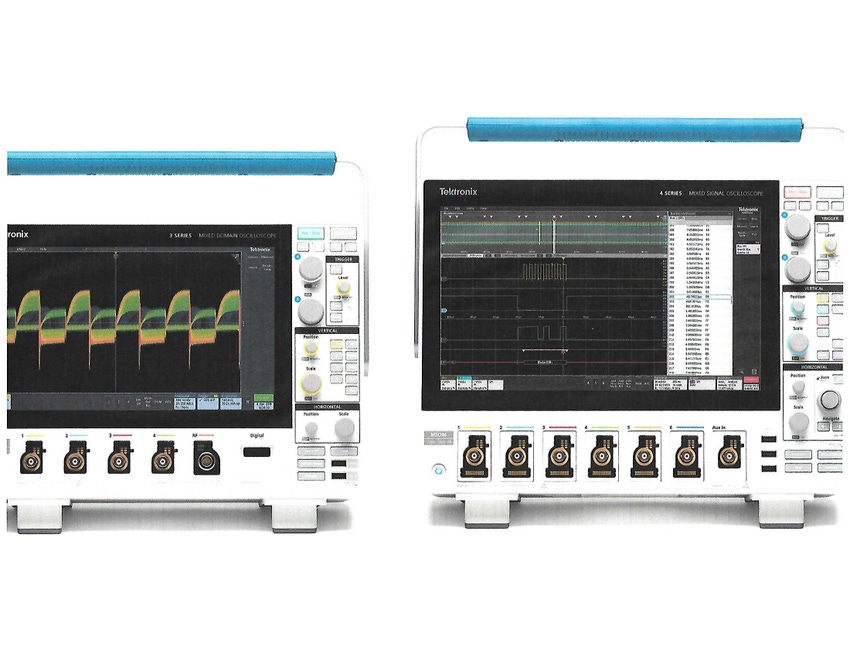Tektronix Rolls Out Mid-Range Scopes with Big HD Displays
New oscilloscopes are targeted at engineers who need to view more analog and digital data streams simultaneously
June 13, 2019

A pair of new mid-range oscilloscopes with big high-definition touch screens promises to simplify development of embedded products, ranging from televisions to IoT- and radio-based devices.
The new 3 Series MDO and 4 Series MSO are being targeted at development engineers that have a growing need to see more signals simultaneously, as electronic products become more complex and deeply integrated. “Traditionally, a scope would have shown two, or maybe four, analog traces on a screen,” noted Dave Slack, product marketing director for Tektronix, Inc., maker of the new scopes. “But anymore, that’s just not enough.”
|
Tektronix’s 3 Series MDO and 4 Series MSO feature big HD displays. (Image source: Tektronix, Inc.) |
Tektronix said the new oscilloscopes enable engineers to view multiple digital data streams, ongoing measurements and databus information, in addition to the conventional analog traces. The 4 Series MSO features a 13.3-inch display with 1920 X 1080 HD resolution, said to be the largest and highest resolution its class. The 3 Series MDO offers an 11.6-inch screen, also with high-definition resolution.
The decision to move to the big, HD screens was based on hundreds of customer interviews around the world by Tektronix engineers. Increasingly, the company said, product developers were saying that the greater complexity of electronic devices was driving a need for more on-screen information.
“There was a time when electronics were built from discrete components,” Slack said. “Radios had individual resistors, capacitors, inductors and an antenna. But nowadays, a radio is a single chip with 8 or 16 bits of digital data going in. And there may be different power voltages going in, along with RF information.” Customers told Tektronix engineers, not only that they needed to see the multiple streams of analog and digital information, but that they needed to view them simultaneously, Slack said.
An industry analyst told Design News that the decision to go with big HD touch screens may also be important for cultural reasons. “Having those big high-resolution screens – that’s what people are used to,” noted Bob O’Donnell, founder of Technalysis Research, LLC, a market research and consulting firm. “When you have an old touch screen, even on your phone, it becomes hard to use. But by moving up to a big, high-resolution touch screen it becomes more intuitive for everyone.”
RELATED ARTICLES:
Both oscilloscopes also offer high in-class performance, Tektronix said. The 4 Series features bandwidths up to 1.5 GHz and sample rates to 6.25 GS/s. The 3 Series offers a range of bandwidths from 100 MHz to 1 GHz and sample rates of 2.5 to 5 GS/s for analog and 8.25 GS/s for digital channels. Cost of the units is $3,850 for the 3 Series MDO and $7,550 for the 4 Series MSO.
O’Donnell added that the combination of mid-range cost and large HD displays may appeal to a growing new swath of product developers. “Especially as you get into the IoT, there’s a whole range of new companies that are having to test electronics that they never had to worry about before,” he told us. “So the screen – and the way you can interact with it – will be important to a lot of engineers.”
Senior technical editor Chuck Murray has been writing about technology for 35 years. He joined Design News in 1987, and has covered electronics, automation, fluid power, and auto.
Drive World with ESC Launches in Silicon Valley This summer (August 27-29), Drive World Conference & Expo launches in Silicon Valley with North America's largest embedded systems event, Embedded Systems Conference (ESC). The inaugural three-day showcase brings together the brightest minds across the automotive electronics and embedded systems industries who are looking to shape the technology of tomorrow. |
About the Author(s)
You May Also Like


.jpg?width=300&auto=webp&quality=80&disable=upscale)


